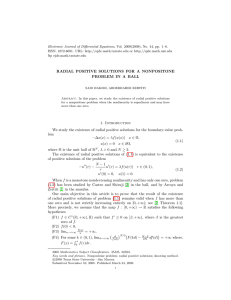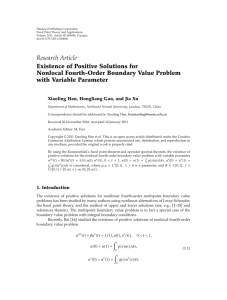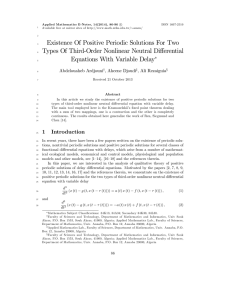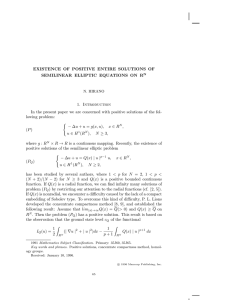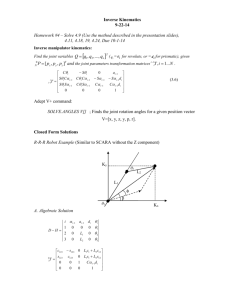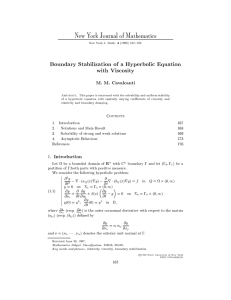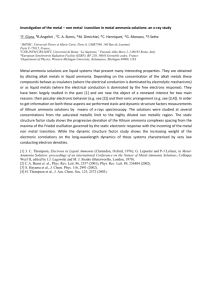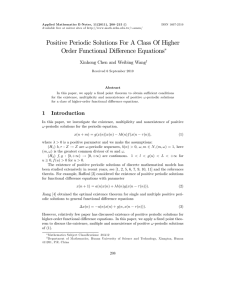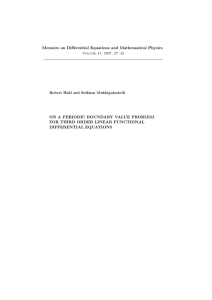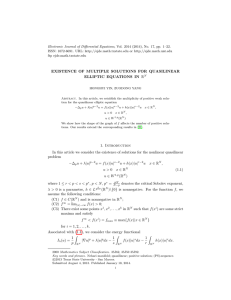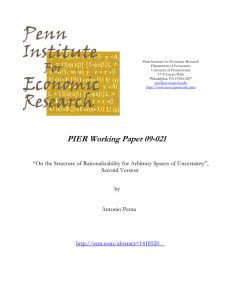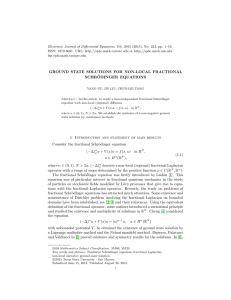Document 10677490
advertisement
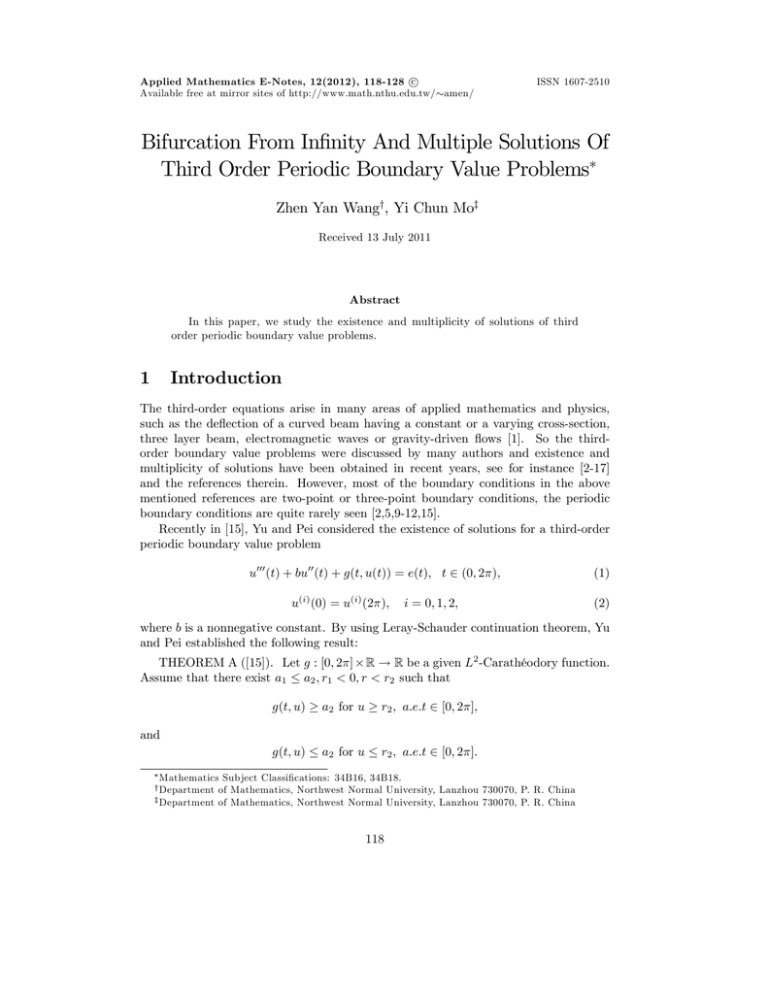
Applied Mathematics E-Notes, 12(2012), 118-128 c Available free at mirror sites of http://www.math.nthu.edu.tw/ amen/ ISSN 1607-2510 Bifurcation From In…nity And Multiple Solutions Of Third Order Periodic Boundary Value Problems Zhen Yan Wangy, Yi Chun Moz Received 13 July 2011 Abstract In this paper, we study the existence and multiplicity of solutions of third order periodic boundary value problems. 1 Introduction The third-order equations arise in many areas of applied mathematics and physics, such as the de‡ection of a curved beam having a constant or a varying cross-section, three layer beam, electromagnetic waves or gravity-driven ‡ows [1]. So the thirdorder boundary value problems were discussed by many authors and existence and multiplicity of solutions have been obtained in recent years, see for instance [2-17] and the references therein. However, most of the boundary conditions in the above mentioned references are two-point or three-point boundary conditions, the periodic boundary conditions are quite rarely seen [2,5,9-12,15]. Recently in [15], Yu and Pei considered the existence of solutions for a third-order periodic boundary value problem u000 (t) + bu00 (t) + g(t; u(t)) = e(t); t 2 (0; 2 ); u(i) (0) = u(i) (2 ); i = 0; 1; 2; (1) (2) where b is a nonnegative constant. By using Leray-Schauder continuation theorem, Yu and Pei established the following result: THEOREM A ([15]). Let g : [0; 2 ] R ! R be a given L2 -Carathéodory function. Assume that there exist a1 a2 ; r1 < 0; r < r2 such that g(t; u) a2 for u r2 ; a:e:t 2 [0; 2 ]; g(t; u) a2 for u r2 ; a:e:t 2 [0; 2 ]: and Mathematics Subject Classi…cations: 34B16, 34B18. of Mathematics, Northwest Normal University, Lanzhou 730070, P. R. China z Department of Mathematics, Northwest Normal University, Lanzhou 730070, P. R. China y Department 118 Z. Y. Wang and Y. C. Mo 119 Suppose also that there exists a function (t) 2 L1 (0; 2 ) with k k1 < 2 such that lim sup jxj!1 g(t; u) u (t); uniformly in a:e:t 2 [0; 2 ]. Then, for every given function e(t) 2 L2 (0; 2 ) with R2 1 e(t)dt a2 , problem (1)(2) has at least one solution. a1 2 0 However, their result gives no information on the interesting problem that nonlinearity crosses the eigenvalues. It is easy to see that 0 is the …rst eigenvalue of the following problem u000 (t) + bu00 (t) = u(t); (3) u(i) (0) = u(i) (T ); i = 0; 1; 2: (4) An interesting problem is what would happen if the nonlinearity crosses the eigenvalue 0. In this paper, we use Leray-Schauder degree and bifurcation technique to consider the existence and multiplicity of solutions of third order periodic boundary value problems u000 (t) + bu00 (t) + u(t) + g(u(t)) = h(t); t 2 (0; T ); (5) u(i) (0) = u(i) (T ); i = 0; 1; 2; (6) 1 where b is a nonnegative constant. g : R ! R is continuous, h 2 L (0; T ), and the parameter runs near 0 which is the …rst eigenvalue of (3)(4). In the paper, we make the following assumptions: (H1) g : R ! R is continuous, and there exist 2 [0; 1), p; q 2 (0; 1), such that jg(u)j pjuj + q; u 2 R: (H2) There exist constants A; a; R; r such that r < 0 < R and g(u) A for all u R; g(u) a for all u r: 0 (H2 ) There exist constants A; a; R; r such that r < 0 < R and g(u) A for all u R; g(u) a for all u r: (H3) g 1 < 1 T where g 1 Z T h(s)ds < g+1 ; 0 = lim sup g(s); s! 1 0 (H3 ) g +1 < 1 T Z 0 g+1 = lim inf g(s): s!+1 T h(s)ds < g 1; 120 Multiple Solutions of Third Order Periodic BVP where g +1 = lim sup g(s); g s!+1 1 = lim inf g(s): s! 1 Our main results are the following THEOREM 1.1. Assume that (H1)-(H3) hold. Then there exist such that + >0> (i) (5),(6) has at least one solution if 2 [0; + ]; (ii) (5),(6) has at least three solutions if 2 [ ; 0). +; THEOREM 1.2. Assume that (H1),(H20 ) and (H30 ) hold. Then there exist with + > 0 > such that (i) (5),(6) has at least one solution if 2 [ ; 0]; (ii) (5),(6) has at least three solutions if 2 (0; + ]. with +; Motivated by bifurcation technique and Leray-Schauder degree developed in [16], which is concerned with second order periodic boundary value problem, in this paper we are concerned with the existence and multiplicity solutions of (5),(6). Since (5),(6) has odd order, there exist di¢ culty in the proof. The rest of the paper is arranged as follows. In Section 2, we discuss the Lyapunov-Schmidt procedure for (5),(6). Section 3 is devoted to the proof of our main results. Finally, we give an example in Section 4. 2 Lyapunov-Schmidt Procedure Let X; Y be respectively the Banach spaces C 2 [0; T ] and L1 [0; T ] with respective norms RT kxk = maxfkxk0 ; kx0 k0 ; kx00 k0 g and kuk1 = 0 ju(s)jds, where kxk0 = maxfjx(t)j : t 2 [0; T ]g. De…ne the linear operator L : D(L) X ! Y by Lu = u000 + bu00 ; u 2 D(L); (7) where D(L) = fu 2 W 3;1 (0; T ) : u(i) (0) = u(i) (T ); i = 0; 1; 2g. Let N : X ! X be the nonlinear operator de…ned by (N u)(t) = g(u(t)); t 2 [0; T ]; u 2 D(L): (8) It is easy to see that N is continuous. (5),(6) is equivalent to Lu + u + N u = h; u 2 D(L): (9) LEMMA 2.1. Let L be de…ned as (7). Then KerL = fx 2 X : x(t) = c; c 2 Rg; ImL = fy 2 Y : Z T y(s)ds = 0g: 0 PROOF. It is easy to see that KerL = fx 2 X : x(t) = c; c 2 Rg. The following RT will prove that ImL = fy 2 Y : 0 y(s)ds = 0g: Z. Y. Wang and Y. C. Mo 121 If y 2 ImL, then there exists u 2 D(L) such that u000 (t) + bu00 (t) = y(t): So 00 00 u (t) 0 0 u (0) + bu (t) bu (0) = Z T y(s)ds: 0 Combining with u(i) (0) = u(i) (T ); i = 0; 1; 2, we have complete. RT 0 y(s)ds = 0: The proof is De…ne the operator P : X ! KerL by Z 1 T u(s)ds; u 2 X: (P u)(t) = T 0 Let Q : Y ! Y be such that Z 1 (Qy)(t) = T (10) T 0 y(s)ds; y 2 Y: (11) Then it is easy to check that P and Q are continuous projectors. Let K(t; s) be the Green’s function of u000 (t) + bu00 (t) = 0; t 2 [0; T ]; Z T u(t)dt = 0; u(i) (0) = u(i) (T ); i = 0; 1; 2: 0 Then K : ImL ! D(L) \ KerP can be given by (Ky)(t) = Z T K(t; s)y(s)ds: (12) 0 Obviously, the linear map K : ImL ! D(L) \ KerP is continuous. LEMMA 2.2. Let P and Q be de…ned by (10) and (11) respectively. Then X = KerP KerL; Y = ImL ImQ: Therefore, for every u 2 X , we have unique decomposition u(t) = + v(t); t 2 [0; T ], where 2 R; v 2 KerP . Similarly, for every h 2 Y , we have unique decomposition h(t) = + h(t); t 2 [0; T ], where 2 R; h 2 ImL. Let the operators Q and K be de…ned by (11),(12). Then K(I Q)N : X ! X is completely continuous and (9) is equivalent to the systems v(t) + Kv(t) + K(I Q)N ( + v(t)) = K h(t); + QN ( + v(t)) = : (13) (14) LEMMA 2.3 ([17]). Assume that (H1) and (H2) hold. Then for each real number s > 0, there exists a decomposition g(u) = qs (u) + gs (u) of g by qs and gs satisfying the following conditions: uqs (u) 0; u 2 R; (15) 122 Multiple Solutions of Third Order Periodic BVP jqs (u)j there exists s pjuj + q + s; u 1; (16) depending on a; A and g such that jgs (u)j s; u 2 R: LEMMA 2.4. Assume that (H1)-(H3) hold. If 0 1 (17) satis…es 1 ; 2kKkIm L!KerP := (18) then there exists constant R0 > 0 such that any solution u of (5),(6) satis…es kuk < R0 : PROOF. We divide the proof into several steps. Step 1. By the assumption (H1), there exists a constant b such that jg(u)j where p = 1 4 1. p juj + b; u 2 R; Using Lemma 2.3 with s = 1, (5),(6) is equivalent to u000 (t) + bu(t) + u(t) + g1 (u(t)) + q1 (u(t)) = h(t); t 2 [0; T ]; u 2 D(L); (19) where q1 and g1 satisfy conditions (15) and (17). Moreover, by (16), jq1 (u)j Let p juj + b + 1: (20) > 0 and choose B 2 R such that (b + 1) for all u 2 R with juj 1 u 1 4 (21) B. It follows from (20) (21) that 0 q1 (u)u 1 p+ 1 4 for all u 2 R with juj B. Step 2. Let us de…ne : R ! R by 8 1 u q1 (u); juj B; > > > < u u 1 (u) = B q1 (B)( B ) + (1 B )p; > > > : B 1 q1 ( B)( u ) + (1 + u )p; B B It is easy to see that (22) 0 u < B; B<u (23) 0: is continuous. Moreover, by (22) one has 0 (u) p+ 1 4 (24) for all u 2 R. De…ning f : R ! R by f (u) = g1 (u) + q1 (u) (u)u; (25) Z. Y. Wang and Y. C. Mo 123 it follows from (22) that for some 2 R, jf (u)j for all u 2 R, where (26) depends only on p and h. Finally, (19) is equivalent to u000 (t) + bu(t) + u(t) + f (u(t)) + (u(t))u(t) = h(t); t 2 [0; T ]; u 2 D(L): Step 3. It is to see that (L + I)jKerP \D(L) : KerP ! ImL is invertible. From (18), 1 k(L + I)jKerP \D(L) kIm L!KerP = kL 1 jKerP \D(L) (I + K) = kKkIm L!KerP k(I + K) 2kKkIm L!KerP : Let u = + v be a solution of (19), where 1 kvk = k(L + I)jKerP \D(L) (I k(L + = 2kKkIm L!KerP k(I 2kKkIm L!KerP k(I = 2kKkIm L!KerP k(I 1 kIm L!KerP kIm L!KerP 2 R; v 2 KerP . Then from (13), Q)(h g( + v(t)))k 1 I)jKerP \D(L) kIm L!KerP k(I 2kKkIm L!KerP k(I 1 Q)kY !Im L [khk1 + p(j j + kvk) + q] Q)kY !Im L [khk1 + p(j j + kvk) + q] kvk ) + q] Q)kY !Im L [khk1 + p(j j) (1 + j j kvk Q)kY !Im L [khk1 + p(j j) (1 + ) + q] j j Q)kY !Im L [khk1 + p(j j) (1 + (j j)1 kvk ) + q]: (j j) kvk c0 c1 Therefore, (jkvk j) (j j) + c1 + (j j)1 (j j) , where c0 = 2kKkIm L!KerP k(I Q)kY !Im L (khk1 + q); c1 = 2pkKkIm L!KerP k(I Q)kY !Im L . If 1 j j (2 c1 ) 1 := c~; then kvk (j j) 2c0 + 2c1 := c: (~ c) (27) Step 4. If we now assume that the conclusion of the lemma is false, we obtain a sequence f n g : 0 n n ! 0 and a sequence fun g : un = n + vn ; 1; n 2 R; vn 2 KerP with kun k ! 1 such that n n + Qg( n + vn (t)) = : (28) It follows immediately from (27) that j nj ! 1; kvn k(j n j) 1 ! 0; n ! 1: (29) 124 Multiple Solutions of Third Order Periodic BVP So we infer that there exists su¢ ciently large n0 2 N such that for n jvn (t)j(j n j) 1 1; n0 t 2 [0; T ]: (30) Without loss of generality, let n ! +1 if n ! +1 (the other case be proved by similar method), then there exists su¢ ciently large n0 2 N. If n n0 ; n n 0, thus Z 1 T g( n + vn (s))ds 0; T 0 Z T 1 g( n + vn (s))ds: (31) lim inf T n!1 0 Now in order to apply the Fatou lemma to (31), we need the existence of a function ^ 2 L1 [0; T ] such that for s 2 [0; T ]; g (un (s)) K(s). ^ K Indeed, from the relation (30), 1 there exists nonnegative function k1 2 L [0; T ] such that for n n0 ; jvn (t)j( 1 n) k1 (t); t 2 [0; T ]; and for every s 2 [0; T ], (un (s))un (s) + f (un (s)) = Let ^ K(s) := It follows from g (un (s)) (p + (un (s))( + vn (s)) + f (un (s)) + vn (s) + f (un (s)) (un (s)) n j nj (un (s))(1 k1 (s)) jf (un (s))j 1 (p + )(1 k1 (s)) : 4 1 )(1 4 n k1 (s)) : ^ K(s) that g( n + vn (s)) ^ K(s); s 2 [0; T ]: Thus, appling Fatou lemma to (31), we have Z T 1 lim inf g( T n!1 0 Z 1 T lim inf g( T 0 n!1 Z 1 T g+1 ds: T 0 n + vn (s))ds n + vn (s))ds This contradicts with (H3). LEMMA 2.40 . Assume that (H1),(H20 ),(H30 ) hold. If 0 1 := satis…es 1 ; 2kKkIm L!KerP then there exists constant R0 > 0 such that any solution u of (5),(6) satis…es kuk < R0 : Z. Y. Wang and Y. C. Mo 3 125 The Proof of the Main Result We have the following LEMMA 3.1. Assume that (H1)-(H3) hold. Then there exists R1 for 0 , and R R1 one has deg(L + I + N h; B(R); 0) = deg(L + I; B(R); 0) = R0 such that 1; where B(R) = fu 2 C[0; T ] : kuk < Rg, and the “deg” denotes Leray-Schauder degree when 6= 0 and coincidence degree when = 0. Then (5),(6) has a solution in B(R) for 0 . PROOF. From Lemma 2.4 and the de…nition of L, if 2 [0; ], then deg(L + I; B(R); 0) is de…ned and is relevant to . Let ( ; u) 2 [0; 1] Lu + u + (N u X be a solution of (9). Then h) = 0: So kuk = k(L + ) 1 (h N u)k k(L + ) 1 kY !X (khk1 + pkuk + q): Therefore there exists R00 > 0 such that kuk < R00 : Choosing R1 = maxfR00 ; R0 g, then for arbitrary R > R1 , deg(L + I + N LEMMA 3.10 . such that for 0 h; B(R); 0) = deg(L + I; B(R); 0) = 1: Assume that (H1),(H20 ),(H30 ) hold. Then there exists R1 , and R R1 one has deg(L + I + N h; B(R); 0) = deg(L + I; B(R); 0) = where B(R) = fu 2 C[0; T ] : kuk < Rg. LEMMA 3.2. Assume that (H1)-(H3) hold. Then there exists 0 one has deg(L + I + N h; B(R); 0) = deg(L + I; B(R); 0) = R0 1; 0 such that for 1; where R is de…ned in Lemma 3.1. Then (5),(6) has a solution in B(R) for PROOF. Let inf kLu + N u hk: 0 = . u2@B(R)\X It is easy to verify that 2 [ ; ], 0 , then if 0 deg(L + I + N > 0. Choosing su¢ ciently small h; B(R); 0) = deg(L + N > 0 such that h; B(R); 0): R < 126 Multiple Solutions of Third Order Periodic BVP Combined with Lemma 3.1, the result can be proved. That is to say, if 2 [ ; ], then (9) has at least one solution in B(R). LEMMA 3.20 . Assume that (H1),(H20 )(H30 ) hold. Then there exists 0 such that for 0 one has deg(L + I + N h; B(R); 0) = deg(L + I; B(R); 0) = 1; where R is de…ned in Lemma 3.1. Then (5),(6) has a solution in B(R) for . REMARK 1 Since g is L-completely continuous and satis…es (H2) and since = 0 is a simple eigenvalue of L, it follows from bifurcation results of [18] that there exist two connected sets C+ ; C R X of solutions of (5),(6) such that for all su¢ ciently small > 0, C+ \ U 6= ;; C \ U 6= ;; where U := f( ; u) 2 R X; j j < ; kuk > 1 g. PROOF OF THEOREM 1.1. Set + = . Then it follows from Lemma 3.1 and Lemma 3.2 that (5),(6) has at least one solution in B(R) for 2 [ ; + ]. On the other hand, Remark 1 shows that there exist two connected sets C+ and C of solutions of (5),(6) bifurcating from in…nity at = 0. Hence by Lemma 2.4, the connected sets C+ and C of Remark 1 must satisfy C+; C f( ; u) : kuk 1 and hence 1 R, i.e. k . Choosing u1 ; u2 : u1 2 C+; u2 2 C , and kui k 1 ; < = maxf ; R; i = 1; 2. < 0g: 1 k g, we obtain two solutions Theorem 1.2 can be proved in similar manners. 4 Example To illustrate Theorem 1.1, we consider the existence and multiplicity of solutions of the following third order periodic boundary value problems u000 (t) + bu00 (t) + u(t) + g(u(t)) = cos t; t 2 (0; T ); (i) (i) u (0) = u (T ); i = 0; 1; 2; where b is a nonnegative constant. 8 > 1 + j sin xj; x > 8; > > 16 <p 3 x; jxj 8; g(x) = > > > : 1 j sin xj; x < 8: 16 (32) (33) (34) Choose p = q = 1; = 21 ; A = 1; a = 1; 8 = r < 0 < R = 8: It is easy to check that (H1) and (H2) hold. It follows from (34) that g 1 = 0; g+1 = 1. Thus (H3) is also satis…ed. By Theorem 1.1, there exist + ; such that + > 0 > and (32),(33) has at least one solution if 2 [0; + ]; and (32),(33) has at least three solutions if 2 [ ; 0). Z. Y. Wang and Y. C. Mo 127 References [1] M. Gregu¼ s, Third Order Linear Di¤erential Equations, Mathematics and its Applications, Reidel Publishing Co., Dordrecht, 1987. [2] A. R. Aftabizadeh, J. M. Xu and C. P. Gupta, Periodic boundary value problems for third order ordinary di¤erential equations, Nonlinear Anal., 14(1990), 1–10. [3] R. P. Agarwal, Existence-uniqueness and iterative method for third-order boundary value problems, Comput. Appl. Math., 17(1987), 271–289. [4] A. Cabada, M. R. Grossinho and F. M. Minhós, Extremal solutions for third-order nonlinear problems with upper and lower solutions in reversed order, Nonlinear Anal., 62(2005), 1109–1121. [5] J. Chu and Z. Zhou, Positive solutions for singular non-linear third-order periodic boundary value problems, Nonlinear Anal., 86(2006), 1528–1542. [6] Z. Du, W. Ge and X. Lin, Existence of solutions for a class of third-order nonlinear boundary value problems, J. Math. Anal. Appl., 294(2004), 104–112. [7] M. R. Grossinho, F. M. Minhós, and A. I. Santos, Existence result for a thirdorder ODE with nonlinear boundary conditions in presence of a sign-type Nagumo control. J. Math. Anal. Appl. 309 (2005), no. 1, 271–283. [8] J. Henderson, Best interval lengths for third order Lipschitz equations, SIAM J. Math. Anal., 18(1987), 293–305. [9] L. Kong and Y. Wang, Positive solution of a singular nonlinear third-order periodic boundary value problems, J. Comput. Appl. Math., 132(2001), 247–253. [10] F. M. Minhós, Periodic solutions for a third order di¤erential equation under conditions on the potential, Port. Math. (N.S.) 55(1998), 475–484. [11] S. Mukhigulashvili, On a periodic boundary value problem for third order linear functional di¤erential equations, Nonlinear Anal., 66(2007), 527–535. [12] P. Omari and M. Trombetta, Remarks on the lower and upper solutions method for second and third-order periodic boundary value problems, Appl. Math. Comput., 50(1992) 1–21. [13] M. Pei and S. K. Chang, Existence and uniqueness of solutions for third-order nonlinear boundary value problems, J. Math. Anal. Appl., 327(2007), 23–35. [14] R. Ma. Multiplicity results for a third order boundary value problem at resonance, Nonlinear Anal., 32(1998), 493–499. [15] H. Yu and M. Pei, Solvability of a nonlinear third-order periodic boundary value problem, Appl. Math. Lett., 23(2010), 892–896. [16] J. Mawhin and K. Schmitt, Landesman-Lazer type problems at an eigenvalue of odd multiplicity, Result in Math. 14(1988), 138–146. 128 Multiple Solutions of Third Order Periodic BVP [17] R. Iannacci, M. N. Nkashama, Unbounded perturbations of forced second order at resonance, J. Di¤. Eqns., 69(1987), 289–309. [18] P. Rabinowitz, On bifurcation from in…nity, J. Di¤. Eqns., 14(1973), 462–475.
